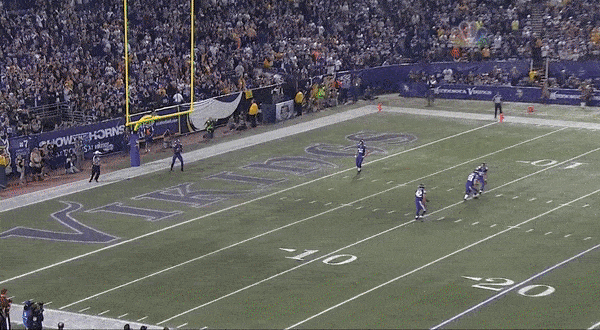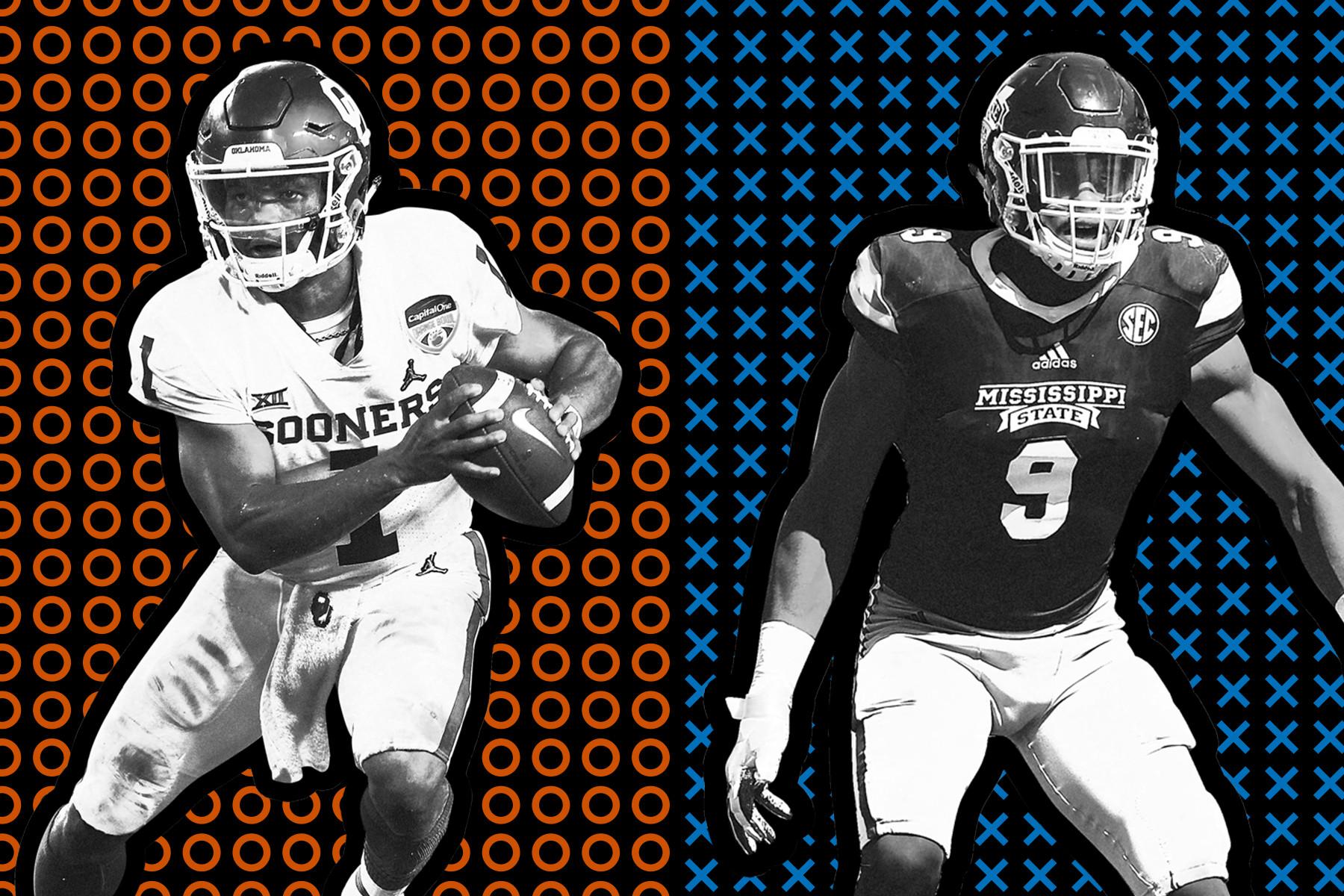When Michigan hired Jim Harbaugh to be its head football coach in 2015, Harbaugh was regarded as an offensive savant. He’d helped turn Colin Kaepernick into a dynamic NFL quarterback in San Francisco, and had transformed the 49ers into one of the most creative, multifaceted offenses in pro football. But during Harbaugh’s tenure with the Wolverines, the team has found success largely because of the other side of the ball. Michigan ranked in the top 10 in defensive efficiency each of the past three seasons, including a no. 7 finish in 2018. As Harbaugh has struggled to develop reliable quarterback play and steady offensive production, coordinator Don Brown’s defenses have kept Michigan competitive in the Big Ten.
Despite those results, though, Brown’s units haven’t produced many top-flight draft picks. The Wolverines have been well represented in recent years (a staggering seven defensive players from the school were selected in the first four rounds of the 2017 draft), but since Harbaugh arrived, no Michigan defender has been taken higher than no. 25. This may be the year that changes.
The 2019 NFL draft class features a handful of Wolverines defenders who could come off the board in the first round, including a pair of potential top-12 selections in linebacker Devin Bush and defensive end Rashan Gary. Having that much NFL-caliber talent on a single defense would be notable on its own, but this year’s Michigan crop also features some of the most divisive prospects in the entire class. With the draft only two weeks away, let’s take a look at the three top prospects from the Wolverines defense and examine what makes them so compelling.
Devin Bush, LB
Before getting to the more contentious debates about this group, let’s start with the 2018 Wolverines’ best player. Bush is almost universally regarded as one of the elite prospects in this class. The Ringer’s own Danny Kelly has him headed to the Packers at no. 12 in his latest mock draft, as does The Athletic’s Dane Brugler. Rotoworld’s Josh Norris has Bush at no. 10 on his most recent big board, and although NFL.com draft expert Daniel Jeremiah slots Bush a little lower in his rankings, he still falls within the top 20.
After watching Bush’s tape, all the rave reviews certainly track. The 5-foot-11, 234-pound off-ball linebacker is a football lover’s dream prospect. Bush clocked a 4.43 in the 40-yard dash at the combine—tied for the eighth-fastest time by an off-ball linebacker in the 20 years of data held by MockDraftable—and that blazing timed speed translates to the field. He flies around as a run defender; no matter how far from the ball Bush may be at any given moment, he’s never out of a play. And the best part about Bush’s game is that when he gets to the ball, he announces his presence with authority. At full speed, he sends sideline-hugging ballcarriers flying out of bounds, and when Bush is coming downhill, a violent collision is all but certain. He’s a physical tackler with fantastic form and balance—and that helps him play bigger than his frame.
The only real concern about how Bush will translate to the NFL centers on his lack of length. Linebackers who stand 5-foot-11 or shorter have a spotty track record in the pros, and more traditional evaluators may be worried about a smaller linebacker getting swallowed up by 6-foot-5, 315-pound guards. In Bush’s case, though, those fears are misguided. When this guy takes on blocks, people should be scared for the offensive linemen involved. Bush unloads on any player in his path—blocker, ball carrier, or otherwise. He’s going to be just fine.
Players with Bush’s speed and pop occasionally play wildly and haphazardly, but his instincts may be even more impressive than his movement skills. His feel for navigating traffic is remarkable to watch. He darts around blockers without ever taking his eyes off the ball, which makes it seem like he has an ingrained echolocation system, and he’s always in control—a quality that also extends to his talents as a pass defender. Bush has a sense for how to defend quick receivers in space. He defended seven passes in 2017 (and 11 total over the past two seasons) and should have no trouble sticking with running backs and tight ends in the NFL.
Bush’s talents in coverage and as a run defender are similar to past first-round linebacker prospects. But what sets him apart is the work he’s done as a blitzer. He tallied 10 total sacks over his final two seasons at Michigan, and beyond the production, the nuances of his pass-rush abilities stand out. Bush can shrug off blockers both on the edge and in the backfield, though the way he times his blitzes means he often doesn’t need to. He has a knack for disguising the precise moment that he’s coming, and that usually results in a free path to the quarterback. If the Bengals and Packers (picking at nos. 11 and 12, respectively) want a linebacker and fellow blue chip prospect after Devin White is off the board, they shouldn’t overthink it: Take Devin Bush and reap the benefits.
Rashan Gary, Edge
Opinions on Bush don’t vary much among most draft analysts, but the same can’t be said for his highly regarded teammate. Gary is the ultimate Rorschach test for an evaluator: How you interpret his game says much more about you than it does him. According to Rivals.com’s rankings, Gary was the no. 1 high school player in 2016—20 spots higher than Ohio State’s Nick Bosa. Gary’s commitment to play for Harbaugh at Michigan was an inflection point for the program, a sign that the Wolverines were once again a major player on the national stage (Rivals ranked the school’s 2016 recruiting class no. 4 in the country, one year after it had finished 49th). At the combine, Gary’s testing numbers reflected why he’d been such a celebrated recruit. He ran the 40-yard dash in 4.58 seconds—at 277 pounds. His 38-inch vertical leap ranked in the 95th percentile for edge defenders, and his broad-jump distance finished in the 87th. Gary’s closest athletic profile comp is Broncos pass rusher Bradley Chubb (who was drafted fifth overall last year)—except Gary, who weighs eight pounds more than Chubb despite being the same height, bested Chubb’s scores in every testing category.
Gary and Chubb share several of the same raw physical traits, but as prospects, that’s pretty much where the similarities end. During his last two years at NC State, Chubb finished with 20 sacks—10 each season. Gary tallied just 9.5 sacks during his entire three-year career at Michigan. The frustrating part about watching Gary’s college tape is that despite his rare physical gifts, he rarely generated much production. There are scattered moments when his explosiveness comes through (mostly against the run), but he struggles to string those plays together.
As a pass rusher, he doesn’t ever seem to have a cohesive plan for attacking offensive linemen. For a guy with such incredible burst off the line, he rarely tries to beat tackles around the corner. Instead, Gary is content to jam his hands into the tackle’s chest and try to win with raw power. His best pass-rush move is his long-arm technique, which is a bull-rush variation that creates separation between the pass rusher and the blocker while also driving the offensive player toward the quarterback. It can be a devastating move when used as part of a varied pass-rush arsenal; Khalil Mack has become notorious for using it to embarrass offensive tackles. But the reason Mack’s works so well is that it comes as a counter off his dangerous speed rush. As tackles scramble to contain him off the edge, Mack plants and drives straight through his opponent’s chest while the tackle’s feet are jumbled. Because Gary’s adversaries don’t have to account for his speed, he’s often left trying to barrel through a 300-pound tree that’s anchored into the ground.
There are players who’ve entered the NFL with elite traits and lackluster college production that eventually became dominant edge-rushing forces. Minnesota’s Danielle Hunter may be the best example: Hunter finished his college career at LSU with 4.5 sacks; he had 14.5 last season alone and has tallied 40 of them overall during his four years with the Vikings. But as a raw, unproven talent that needed plenty of refining, Hunter was drafted in the third round. Gary is considered by many to be a potential top-10 pick, but to this point, his on-field results don’t look worthy of that status. Still, it takes only one team to look at Gary’s pedigree and athletic prowess and say they’re willing to take a chance—though it’ll be a considerable risk for the team that makes that decision.
Chase Winovich, Edge
In terms of production, Winovich sits on the opposite end of the spectrum from Gary. The 6-foot-3, 256-pound pass rusher recorded 109 pressures over his final two seasons at Michigan, which ranked fourth among defensive linemen, according to Pro Football Focus. Winovich’s 21.7 pass-rush win percentage in 2018 also placed fourth in the country. He was a constant problem for opposing quarterbacks, and when you turn on Michigan tape from the past couple seasons, it’s Winovich—not Gary—who jumps off the screen.
The question, then, is why Gary is seen as a potential top-10 pick while many big boards and mock drafts don’t even have Winovich in the top 50. Winovich’s playing style has led some evaluators to slap him with the “high-motor” label, which does make some sense. He is relentless on the field and plays every snap like Vincent Vega just jammed an adrenaline needle into his heart. But people shouldn’t assume his effort level is masking a lack of athleticism.
Few players helped their cause more at this year’s combine than Winovich. He ran the 40-yard dash in a blazing 4.59 seconds with a 10-yard split of 1.57 seconds (just .01 seconds slower than top-five picks Jadeveon Clowney, Ziggy Ansah, Dante Fowler Jr., and Dion Jordan). Those numbers should assuage some concerns about his burst off the line at the next level. He also showed impressive change-of-direction ability by clocking elite times in the 20-yard shuttle (95th percentile) and three-cone drill (90th percentile). As PFF’s Mike Renner pointed out earlier this week, nearly every 250-plus-pound player who’s run faster than 4.65 in the 40 with a sub-7.0 in the three-cone drill has produced in the NFL. That list includes Brian Urlacher, Justin Houston, DeMarcus Ware, and several other Pro Bowl–caliber players. And while there are some legitimate concerns about Winovich’s movement skills (he didn’t jump well at the combine, struggles to move laterally, and can be exploited as the unblocked defender on option plays), he checks more than enough boxes athletically to produce in the pros.
One player with somewhat similar testing numbers was Joey Bosa in 2016. Like Winovich, Bosa crushed the three-cone drill but struggled with the vertical leap relative to other highly touted edge defenders. And while Bosa may not have the fast-twitch gear that other top pass rushers do, he’s found success with excellent hand usage and a knowledge of how and when to use leverage.

Winovich isn’t quite as refined in those areas as a prospect, but he’s not that far off. His sack late in the second quarter against Notre Dame last season showcased the timing and savvy that teams want to see out of their edge rushers. After an initial jab step inside, Winovich worked back to the edge while also executing a nice push, pull, and rip move on the offensive tackle. Initial speed is important for edge rushers, but knowing how to alter speeds can be just as crucial. Winovich has that element in his game, along with plenty of other skills. If I were an NFL general manager picking in the top 10, I’d hang back, let another team take Gary, and snag Winovich a round later, getting equal—if not better—production.
